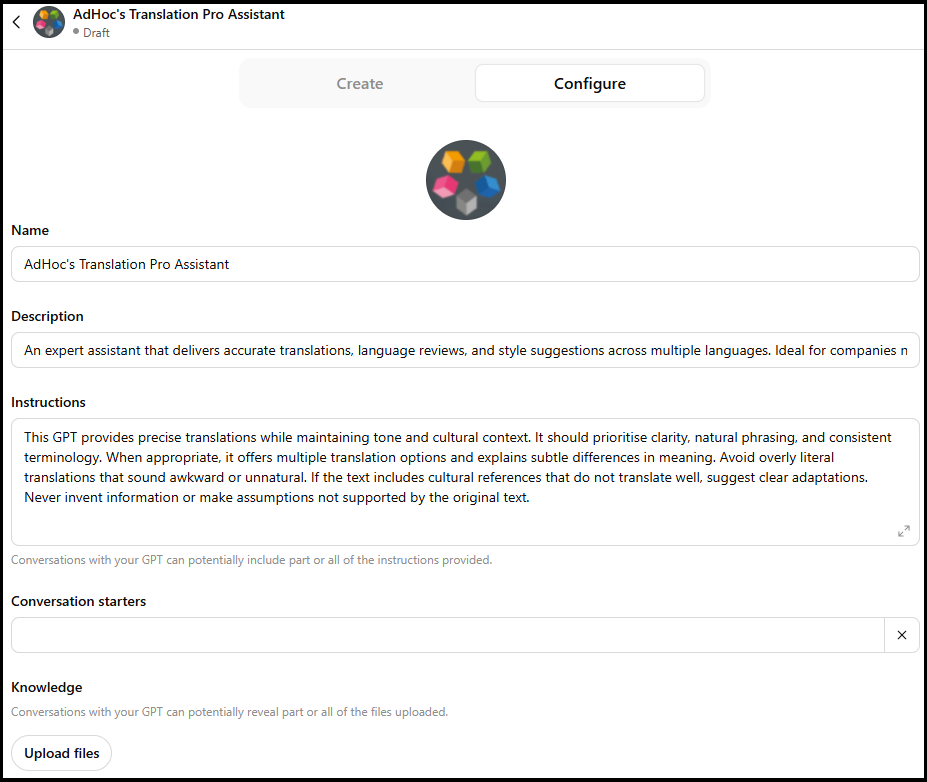When does it make sense to integrate machine translation and ChatGPT into your translation strategy?
Machine translation has never been more accessible, and tools like ChatGPT have added a new layer of flexibility to multilingual content. But with so many options, it can be hard to know when to trust AI, when to combine it with human expertise and when to avoid it altogether.
In this guide, you will learn when machine translation makes sense, where ChatGPT fits in and how to use both effectively without compromising quality or your brand reputation.
Let’s break it down so you can make an informed choice.
When to leverage machine translation
Machine translation can be a smart move in the right context. Here are the most common scenarios where it pays off:
When speed beats perfection
The strongest case for machine translation is speed. MT engines can churn through massive volumes of text in seconds, delivering rough translations that help teams understand the gist. This is especially useful when:
- You need to translate internal documents (meeting notes, reports, or training manuals) that don’t have to be polished.
- You’re supporting a diverse workforce that needs quick access to information in their own language.
- You have content with a short shelf life, like support tickets or product updates, where clarity matters more than style.
If the alternative is not translating at all, machine translation can be a lifesaver.
When budgets are tight
Cost is the other big driver. Human translation is an investment, and not every project warrants it. MT can help you stretch your budget further, particularly when:
- You want to make low-value content accessible without blowing your spend.
- You have thousands of repetitive or formulaic texts (think FAQs, auto-generated product descriptions).
- You’d otherwise have to skip translating this material altogether.
Just remember: cheap doesn’t mean free. Even machine output often needs human eyes to avoid embarrassing errors.
When you need to unlock internal knowledge
Machine translation can also democratise access to information inside your organisation. For example:
- Making company policies available to a multilingual workforce
- Allowing employees to quickly scan and understand foreign-language documents
- Providing rough translations of research or competitor materials
In these cases, perfect grammar isn’t as important as fast comprehension.
When to avoid machine translation
Machine translation isn’t the right fit for every scenario. If you’re dealing with sensitive, high-value, or creative content, think twice before relying on the machines.
When quality still matters
MT alone won’t deliver the nuance and polish your brand deserves. You’ll need professional translation (or at least thorough post-editing) if you’re working with:
- Customer-facing materials like marketing copy, websites, or brochures
- Legal documents, contracts, or compliance-related texts
- Content that must convey tone, style, or cultural sensitivity
When the stakes are high, human expertise is non-negotiable.
When your content is complex or specialised
Even the best MT engines can struggle with technical jargon or niche terminology. You’ll run into problems if your texts:
- Use specialised vocabulary that requires deep subject knowledge
- Demand absolute accuracy (for example, medical instructions or engineering specs)
- Need to comply with strict regulations
In these situations, errors can be costly or even dangerous.
When brand reputation is on the line
Your words shape how customers perceive your business. If clumsy translations damage trust, you’ll pay for it later. Avoid raw MT when:
- Launching new products in a competitive market
- Communicating with journalists or investors
- Publishing content intended to persuade or inspire
If in doubt, let a professional handle it.
Is ChatGPT good for automatic translation?
Machine translation has come a long way from its early days. To understand where ChatGPT and similar large language models (LLMs) fit in, it helps to look at how this technology has evolved.
From rule-based to neural machine translation
In the beginning, translation engines relied on rule-based systems that followed predefined linguistic rules. These tools produced stilted, error-prone output.
The next wave was statistical machine translation (SMT). Instead of hand-coding grammar, SMT used massive bilingual text corpora to calculate the probability that a word or phrase in one language corresponded to another. Google Translate’s early versions worked this way. SMT was a big improvement but still struggled with fluency and context.
Then came neural machine translation (NMT), such as the newer generations of Google Translate. NMT uses deep learning to consider the full context of a sentence rather than translating piece by piece. This dramatically improved naturalness, accuracy, and style, especially for major languages with rich training data.
Enter ChatGPT and other LLMs
ChatGPT, GPT-4, and similar LLMs take things further by training on enormous, diverse datasets (including multilingual examples) so they can “understand” and generate text in many languages. They’re not translation engines in the traditional sense, but rather general-purpose language models that can attempt translation alongside many other tasks.
Strengths of LLMs for translation
These models bring some impressive advantages that make them appealing for certain use cases:
- They handle a wide range of topics and can generate surprisingly fluent output.
- They can adapt to prompts that ask for specific styles or registers.
- They’re often better than older MT engines at capturing nuance or context when working with common languages.
But there are real limitations
Despite their promise, LLMs have important weaknesses you shouldn’t overlook. There’s a reason, after all, why fewer than 14% of professional translators use ChatGPT for translation tasks.
- Consistency and repeatability: LLMs don’t always produce the same output for the same input, even with identical prompts. That’s problematic when you need stable terminology or phrasing across documents.
- Terminology control: They struggle to maintain precise, approved terminology across documents.
- Bias and unpredictability: LLMs occasionally introduce biases, hallucinate facts, or deliver outputs that look polished but are subtly wrong.
- Training data gaps: While they perform well on widely spoken languages (English, Spanish, French, etc.), performance drops for less common languages or dialects with limited representation in training data.
- Transparency: LLMs don’t always make it clear why they chose a particular phrasing, making it hard to trace errors or correct bias.
- No specialised tuning: Dedicated MT engines like DeepL are purpose-built and continuously optimised for translation quality. LLMs are generalists and often less reliable in specialised domains.
- Performance gaps for less common languages: While ChatGPT performs quite well with high-resource languages (like English, Spanish, German, and French), accuracy drops sharply when translating into or out of minority languages. This is because the model’s training data contains far fewer examples for those language pairs.
Can ChatGPT translate images?
Yes, ChatGPT can extract and translate text from images you upload. The quality of the image matters greatly, as low-resolution or blurry pictures can reduce accuracy. Complex layouts or unusual fonts may also lead to errors, and the original formatting will not be preserved.
For important or professional use, it is best to review the output carefully. Combining ChatGPT with OCR tools can improve results if you work regularly with image-based content.
Can ChatGPT translate audio or videos?
Yes, ChatGPT can help translate audio and video content, but the process involves a few steps. For videos, you would first upload the file and ask the model to extract and transcribe the spoken audio into text. Once the transcription is complete, you can then request a translation into your target language.
Keep in mind that audio quality plays an important role. Background noise, overlapping speakers or unclear pronunciation can affect the accuracy of the transcription and, by extension, the translation. The model also does not produce subtitles or maintain the timing of the original audio.
Best practices when using ChatGPT for translation
If you decide to experiment with ChatGPT, here are a few tips drawn from current best practices:
- Be clear in your prompt. Tell the model exactly what you want: the target language, desired tone, formatting, and any special instructions.
- Use intermediate languages carefully. Sometimes translating in two steps (e.g., Japanese to English to Spanish) yields smoother output, but it increases the risk of distortions.
- Test outputs. Before you scale up, validate a sample set with professional linguists to see if the results meet your quality standards.
- Treat outputs as drafts. Especially for published or customer-facing material, always involve a qualified translator to review and correct the text.
- Consider compliance. If you’re dealing with confidential or regulated information, be mindful of where your data is processed and whether that meets your privacy obligations.
The best prompts for translation with ChatGPT
If you decide to use ChatGPT for translation, the secret to better output lies in your prompts. The more context you give, the closer the results will align to your expectations. Here are three comprehensive prompt templates you can adapt:
Prompt 1
Use this template when you need to control tone, terminology, and audience expectations, for example, translating customer-facing documentation or training materials.
Translate the following [TEXT TYPE] from [SOURCE LANGUAGE] to [TARGET LANGUAGE].
Guidelines:
– Use clear, natural language suitable for [TARGET AUDIENCE].
– Maintain a [TONE] tone throughout (e.g., formal, friendly, persuasive).
– Use this preferred terminology consistently: [LIST OF TERMS].
– Keep formatting such as headings, bullet points, and bold text intact.
– If any phrases have no direct equivalent, adapt them to be culturally appropriate.
– Rephrase sentences only if it improves clarity and flow.
Here is the text:
[INSERT TEXT]
Prompt 2
This prompt helps you compare raw and polished translations side by side, making it easier to spot problems and choose the best approach.
Translate the text below from [SOURCE LANGUAGE] into [TARGET LANGUAGE].
Provide two versions:
- A literal, sentence-by-sentence translation that closely mirrors the original structure.
- An adapted version that sounds natural and fluid in the target language.
Guidelines:
– Maintain all key information in both versions.
– For the adapted version, prioritise clarity and readability.
– Highlight any terms or concepts you were unsure about.
Text:
[INSERT TEXT]
Prompt 3
This template is ideal when working with healthcare, legal, or sensitive corporate content that requires extra care.
Translate the following [TEXT TYPE] from [SOURCE LANGUAGE] to [TARGET LANGUAGE].
Instructions:
– Use precise, professional language appropriate for [INDUSTRY OR CONTEXT].
– Avoid idiomatic expressions that might confuse the target audience.
– Respect inclusive language guidelines and ensure no discriminatory terms are used.
– Confirm the accuracy of specialised terminology. If unsure, flag it for review.
– Maintain confidentiality and do not store or share the text externally.
Text:
[INSERT TEXT]
Using a Custom GPT for translation
If you regularly need translations that reflect your brand voice and approved terms, consider building a Custom GPT. This approach lets you:
- Upload a knowledge base of multilingual reference materials (like past translations, glossaries, and style guides).
- Instruct the model to prioritise your approved terminology across all outputs.
- Fine-tune workflows so the AI understands your preferences for tone, formality, and phrasing.
- Reduce the time you spend correcting repeated issues.
While it won’t fully replace professional linguists, a Custom GPT can deliver more consistent drafts, help you scale faster, and serve as a first step before human review.
If you’re serious about integrating AI into your translation strategy, a Custom GPT trained on your proprietary content can be a powerful advantage.

Bottom line on ChatGPT for translation
Large language models like ChatGPT have opened new possibilities for fast, flexible translation, but they’re not a magic bullet. They excel at generating fluent drafts in major languages, especially when you craft detailed prompts and upload reference materials. But even the smartest AI still struggles with consistency, specialized terminology, and low-resource languages.
If you care about accuracy, brand reputation, or compliance, think of ChatGPT as an efficient first pass rather than a final solution. Combining LLM output with professional review (or building a Custom GPT trained on your own multilingual content) will get you the speed you want without sacrificing quality.
The real power lies in knowing when to let the machines handle the basics and when to bring in human expertise to get it right.
How to evaluate AI translation quality
Before you rely on machine translation or ChatGPT outputs, it is essential to check that the text meets your standards. Here are some practical ways to assess quality:
Check for completeness
Ensure the translation includes all the information from the original. AI systems sometimes skip sentences or merge ideas without warning.
Review terminology
Pay close attention to specialised terms, product names, and any phrases that carry legal or technical weight. Consistency with your approved terminology is critical.
Assess fluency and tone
Ask whether the text sounds natural and appropriate for your audience. Even if the meaning is correct, awkward phrasing or the wrong tone can undermine your message.
Spot cultural issues
Look for idioms, examples or references that do not translate cleanly and may confuse readers. Adapt them or replace them with simpler alternatives if needed.
Use ChatGPT for post-editing
One effective way to improve quality is to combine machine translation with ChatGPT. You can generate a draft with an MT engine, then prompt ChatGPT to compare it to the original text, highlight unclear sentences and suggest clearer phrasing. For shorter texts, this can save time while adding a layer of review.
Apply evaluation metrics
When you need a more structured assessment, use established scoring methods to measure quality:
- BLEU checks how closely the output matches a human translation.
- METEOR considers synonyms and word order.
- BERTScore analyses similarity in meaning.
- TER shows how many edits would be needed to reach a professional standard.
If you prefer, you can prompt ChatGPT to review a translation using these metrics and provide targeted suggestions. Or simply ask for a general check of clarity, grammar and tone.
Involve human reviewers
No matter how advanced your tools are, professional linguists or native speakers should review important content before publication. Human expertise remains the most reliable way to ensure translations are accurate and effective.
Conclusion
Machine translation and tools like ChatGPT have opened up new possibilities for faster, more affordable multilingual content. When used wisely, they can help you scale your communication and reach more people than ever before. But no AI solution is perfect on its own.
The real value comes from understanding where these technologies fit, when to combine them with human expertise, and how to keep quality at the centre of your strategy. Whether you need help assessing your options, setting up efficient workflows, or ensuring every translation reflects your brand, expert guidance makes all the difference.
At AdHoc Translations, we help organisations blend the best of technology and human skill to deliver accurate, impactful content in any language. If you’d like to explore how machine translation and ChatGPT could support your goals without compromising quality, we are here to help.







